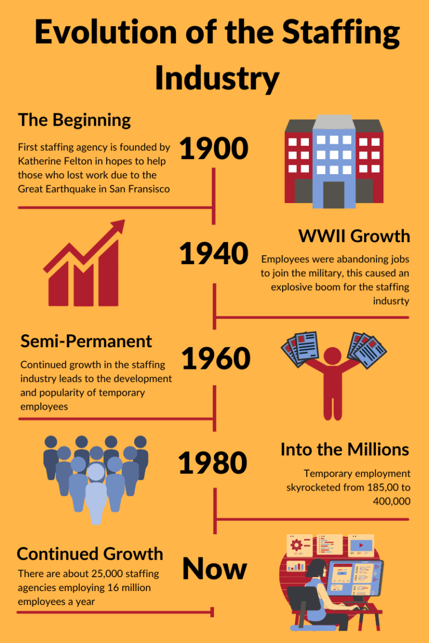The staffing industry has gone through many changes since the first agency was founded in 1906. Staffing agencies operate within the business services industry, finding workers for client companies. Unlike recruitment companies, staffing firms primarily deal with temporary and contract positions. Companies depend on staffing employees to help them get through busy seasons, support significant projects, and foster business growth. Staffing agencies provide a company with customized services based on their resources and needs.
 The staffing industry is a significant contributor to our economy; according to the latest staffing industry forecast from SIA, the temporary staffing revenue will reach $134.7 billion in 2021. Staffing is an essential industry that provides vital flexibility and support to businesses and opportunities for employees. With the ever-evolving economy, the staffing, recruiting, and workforce solutions industry is prepared to support businesses.
The staffing industry is a significant contributor to our economy; according to the latest staffing industry forecast from SIA, the temporary staffing revenue will reach $134.7 billion in 2021. Staffing is an essential industry that provides vital flexibility and support to businesses and opportunities for employees. With the ever-evolving economy, the staffing, recruiting, and workforce solutions industry is prepared to support businesses.
Early 1900’s:
The first known employment agencies in the United States started around the early 1900s. The first and most notable agency is the agency started by Katherine Felton after the Great Earthquake in San Francisco. She created this agency to help those who lost work due to the earthquake and help revive the economy.
1940-1950:
While staffing agencies have been around since the early 1900s, the industry did not take off until the 1940s. The staffing industry grew enormously in the 1940s when employees left their positions to join the military during WWII. The influx in workers joining the military caused an extreme lack of talent and an increase in open positions leading to a high need for staffing agencies. During this time, more staffing agencies were established due to the high demand of businesses to help them quickly fill positions. The postwar economic boom followed this hiring influx. The staffing industry continued to grow, and soldiers returning home relied heavily on staffing agencies to find work.
1960-1970:
The continuous development of the staffing industry led to an expansion into administrative and temporary work. This period is marked by iconic
“Kelly Girl” ads and the rise of “semi-permanent employees.” Temporary workers became an affordable option for many companies struggling to employ full-time staff amid the economic hardships of the 1970s. Temporary roles began to expand from clerical work to engineering, accounting, programming, and other professions.
1980-2000:
The 1980s showed robust growth for the staffing industry. Temporary employment skyrocketed from 185,000 temps to over 400,000. Before the end of the 1980s, the daily amount of temporary employees surpassed one million. Despite the economic up and downs of the 1990s, the rise of the staffing industry continued.
Today:
Staffing industries are more prominent than ever. About 25,000 staffing and recruiting agencies in the U.S. offer career opportunities for 16 million employees per year. According to a U.S. Government accountability report, 40 percent of the U.S. workforce is composed of contingent or temporary workers. Staffing industries have evolved to meet the needs of businesses providing many services beyond recruitment. They now match companies across all sectors with employees of any skill level and offer a wide range of services, from recruitment marketing to workforce planning and strategy.
Predictions for the Future of The Staffing Industry:
The recent volatility of the labor market has led many organizations to rely more heavily on project-based assignments and to employ a contingent workforce; this trend will continue in the years to come. The continual growth in technology will lead to further automation of many tasks and roles. The popularity of staffing and recruitment firms will continue to rise as many organizations opt for the ease of outsourced human resource functions. Despite the economic downfall of 2020, the staffing industry is predicted to increase steadily.
